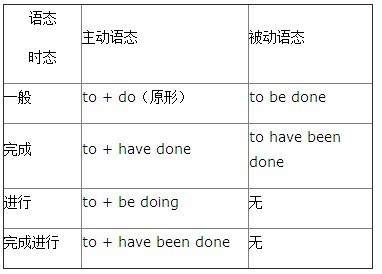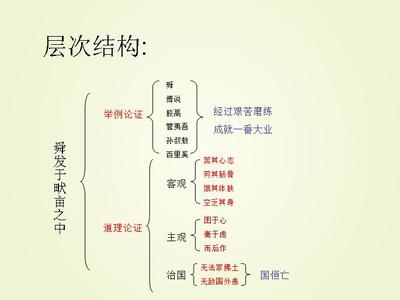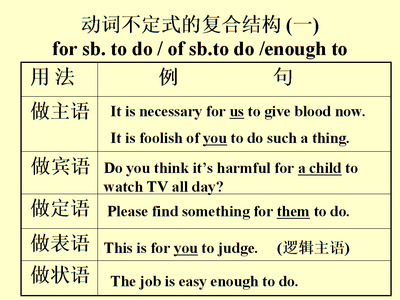1.不定式的基本形式与结构
动词不定式指通常由to加上动词原形 (如to write)所构成的一种非限定性动词形式,但在有些情况下to可以省略。动词不定式有进行体和完成体(如上tobe writing,to have written),也有被动态(如to bewritten),所有的主动词,不论是及物动词还是不及物动词,也不论是动作动词还是状态动词,都有不定式形式。助动词除be和have外,没有不定式形式。动词不定式在语法功能上可作主语、宾语、表语、定语和状语。
2.不定式的用法
1)不定式结构作主语
1.Te get contact with his family in Taiwan made him extremely happysince they separated more than 40 years ago.
2.To finish that task in such a short time is really achallenge.
在上述情况下,如果不定式较长,显得头重脚轻,则可由代词让作形式主语(形式主语it不可由that或this等其他代词代替),而将不定式放到后面。如:
1.It made him extremely happy to get contact with his family inTaiwan since they separated more than 40 years ago.
2.John admitted that it is always difficult for him to be ontime.
不定式结构所表示的动作是谁做的,即不定式的逻辑主语,通常可以通过forsb. to do sth. 结构表达:
1.It is quite important for us to read good books during a generalreview.
2.It is not difficult fot those talented students to pass theexam.
在某些形容词(如careless,clever,considerate,foolish,good,impolite,kind,naughty,nice,silly,stupid等)作表语时,不定式后可以加of来引导出其逻辑主语:
1.It is very kind of you to tell me the truth.
2.It is stupid of him to do such a silly thing.
2)不定式作宾语
不定式作宾语有两种:一种是及物动词后直接跟带to的不定式,另一种是“及物动词+疑问词+带to的不定式。
及物动词+带to的不定式结构:
只能跟动词不定式的动词,常见的有: afford, agree, aim, appear, ask,believe, care,claim,decide demand, desire, determine, expect,fail, happen, hesitate, hope, intend, learn, long, manage, offer,pretend, promise, prepare, refuse, seek, swear, undertake,want,wish等。
1.He managed to solve the complicated problem.
2.The stranger offered to show me the way.
3.Mr. Smith undertook to build a new plant in South Africa.
动词+疑问代(副)词+不定式:
这类动词常见的有advise, decide, find out, forget, inquire, know,learn, see, regard, remember, teach, tell, understand,wonder等。常见的疑问代(副)词有: what, when, where, which, how,whether等。
1.He does not know when to start.
2.You can decide whether to continue or to stop.
3.I will show you how to deal with it.
有时,不定式可由it代替,而把不定式放到后面去。这可以用这一结构表达:动词(如find,think,consider,feel等)+it+ 形容词+不定式。
1.She considers it necessary to make friends with him.
2.We find it difficult to finish all the homework before 9o’clock.
3)不定式做表语
一种情况为主语是不定式(表示条件);表语也是不定式(表示结果):
1.To see is to believe.
2.To work means to earn a living.
另一种情况为主语是以aim,duty,hope, idea,job, plan,problem,purpose,thing,wish等名词为中心的短语,或以what引导的名词性从句,不定式表语对主语起补充说明作用:;例如:
1.His aim is to study abroad in the near future.
2.The most important thing is to negotiate with them about theprice.
3.What I want to say is to forget all the unhappyexperience.
4)不定式作定语
不定式结构作名词词组修饰语主要有三种类型:
第一种,被修饰的名词词组是不定式的逻辑宾语。例如:
1.There was really nothing to fear.
2.He gave me an interesting book to read.
如果不定式是不及物动词,后面就得加相应的介词。例如:
1.Mary needs a friend to play with.
2.That girl has nothing to worry about.
3.They have a strict teacher to listen to.
4.Although the film had been on for ten minutes, I still was notable to find a chair to sit on.
第二种,被修饰的名词词组是不定式的逻辑主语;例如:
1.Have you got a key to unlock the door?
2.The action to be taken is correct.
3.There is nothing to be gained by pretending.
第三种,被修饰的名词词组是不定式的同位结构。这类名词通常是表示企图、努力、倾向、目的、愿望、is算、能力、意向等意义的名词:ability,attempt, effort, impulse, inclination,wish等。例如:
1.Her daughter will make an even bigger effort to pleaseher.
2.I have no wishto quarrel withyou.
3.Neither of them had any inclination to do business withMary.
5)不定式作状语
不定式结构在句中作状语通常都能转换为限制性状语从句。例如作原因状语:
1.They are quite surprised to see the great changes taking place inthe area.
2.They are quite surprised because they see the great changestaking place in the area.
3.He was lucky to arrive before dark.
4.He was lucky because he arrived before dark.
作目的状语:
1.She raised her voice to be heared better.
2.She raised her voice so that she could heard better.
3.We went via Heidelberg to miss the traffic jam.
4.We went via Heidelberg so that we could miss the trafficjam.
作结果状语:
1.The French football team played so successfully as to defeat theBrazilians.
2.The French football team played so successfully that they evendefeated the Brazilians.
3.He got to the station only to be told the train had gone.
4.He got to the station and was told that the train hadgone.
不带to的不定式的使用
动词不定式通常带to,但在有些搭配中不带to,在另一些搭配中可带to可不带to。归纳起来,以下情况下使用不带to不定式:
1) 在can/could,/may/might,will/would,shall/should,must,need,dare等情态动词之后,动词不定式不带to。
2)在表示感觉意义的动词,如see,feel,watch,notice,smell,hear,observe等后,或是表示“致使”意义的动词,如have,let,make等后,动词不定式不带to。例如:
1.I often heard him say that he would study hard.
2.I must have him see his own mistakes.
但是,当这类结构转换为被动语态时,后面的不带to不定式一般转换为带to不定式。
例如:
1.He was often heard to say that he would study hard.
2.After he had finished speaking,he was made to answer innumerablequestions.
3)在动词help之后可用不带to的不定式,也可用带to的不定式。例如:
1.Help the old lady (to) carry the heavy box.
4) 在had better,would rather,may/might aswell,rather than,can notbut等搭配之后,动词不定式也不带to。例如:
1.Unless you feel to ill to go out,I would rather not stay at hometonight.
2.She could not but criticize his foolish behaviour.
5) 在make do,make believe,let drop,1etfall,1et fly,let slip,let drive,let go off,hear say,heartell,leave go of等固定搭配中,用不带to的动词不定式。例如:
1.They let go of the rope.他们松开了绳子。
2.John let fly a torrent of abuse at me.约翰朝我痛骂了一顿。
3.I've heard tell of him.我听说过他。
4.Some of the faculty were let go for lack of thestudents.由于生源不足,一些教职员工被解雇了。
6)在介词but,except之后,如果其前有动词do的某种形式,其后不定式一般不带to,反之则必须带to,表示“不得不,只能”。例如:
1.He will do anything except work on the farm.
2.There was nothing left for the enemy to do but surrender.
3.The spy was both hungry and cold;there was nothing left for himbut to give in.
4.I had no choice but to wait till it stopped raining.
下面一些短语是固定搭配,不带to:
can not help but,can not choose but,can not but,do nothingbut,have nothing to do but。例如:
I can not but admire his courage.
如果上述句中有do,to省略:
I did nothing but watch TV last night.
如果是下面一个固定搭配,就带to:

I have no choice but to give up my idea.
7)紧跟在why或whynot之后的动词不定式总是不带to。但是,紧跟在who,what,which,whether等连接词后的不定式带to。例如:
Why stand up if you can sit down?
Why not ask your teacher when you don't understand themeaning?
You needn't decide yet whether to study arts or science.
4.不定式的完成式和进行式
1)构成
完成式:to+ have done
进行式:to+ be doing
2)用法
完成式:如果不定式所表示的动作(状态)发生在主要谓语动作之前,那么不定式就要用其完成式。
进行式:如果主要谓语动作(情况)发生时,不定式所表示的动作正在发生,那么不定式就要用其进行式。例如:
1.She feels relaxed to have finished writing her thesis before thedeadline.
2.The Vikings are believed to have discovered America.
3.When you called me last night, I happened to be working on thecomputer.
5.不定式的被动形式
当不定式的逻辑主语是动作的承受者时,不定式要用被动形式,包括它的一般式和完成式。例如:
1.For twelve years, Spanish censorship did not allow Lorca's nameto be mentioned and his work to be published.
2.The snow was supposed to have been blown off the mountain.
6.不定式的否定形式
否定形式是在不定式的标志to前加not。例如:
1.I decided not to ask him again.
2.Please remember not to leave the lights on when you areout.
 爱华网
爱华网



